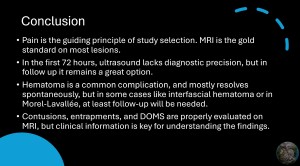Congress:
ECR25
Poster Number:
C-24402
Type:
Poster: EPOS Radiologist (educational)
DOI:
10.26044/ecr2025/C-24402
Authorblock:
F. N. Avalos, P. A. Daza, C. Almeida Cedeño, J. B. Silva Hidalgo, D. Perez; Quito/EC
Disclosures:
Fernanda Natalia Avalos:
Nothing to disclose
Pedro Andres Daza:
Nothing to disclose
Carlos Almeida Cedeño:
Nothing to disclose
Jorge Bolivar Silva Hidalgo:
Nothing to disclose
Dayana Perez:
Nothing to disclose
Keywords:
Musculoskeletal system, CT, MR, Ultrasound, Education, Acute
Pain is the guiding principle of study selection. MRI is the gold standard on most lesions. Also, it is important to mention that in the first 72 hours, ultrasound may not be able to adequately diagnose muscle tears. But for follow-up, it remains a great option.
When evaluating muscle tears the key point is to identify the anatomical structure compromised, measurement is important too but is secondary.
Hematoma is a common complication, and mostly resolves spontaneously, but in some cases like interfascial hematoma or in Morel-Lavallée, at least follow-up will be needed.
Contusions, entrapments, and DOMS are properly evaluated on MRI, but clinical information is key for understanding the findings.

Fig 22: CONCLUSION